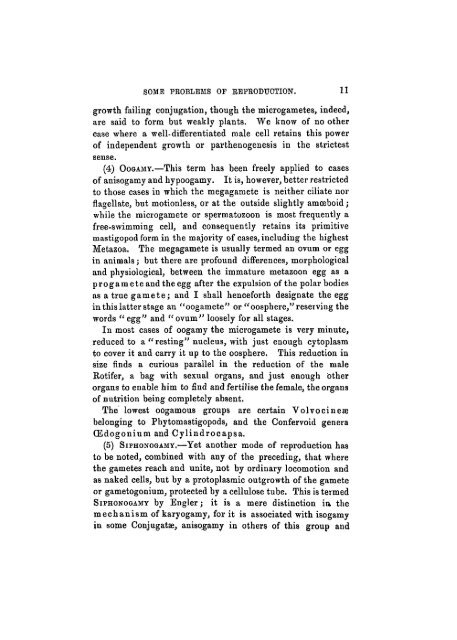Some Problems of Reproduction: a Comparative Study of ...
Some Problems of Reproduction: a Comparative Study of ...
Some Problems of Reproduction: a Comparative Study of ...
Create successful ePaper yourself
Turn your PDF publications into a flip-book with our unique Google optimized e-Paper software.
SOME PROBLEMS OF REPRODUCTION. 11<br />
growth failing conjugation, though the microgametes, indeed,<br />
are said to form but weakly plants. We know <strong>of</strong> no other<br />
case where a well-differentiated male cell retains this power<br />
<strong>of</strong> independent growth or parthenogenesis in the strictest<br />
sense.<br />
(4) OOGAMY.—This term has been freely applied to cases<br />
<strong>of</strong> anisQgamy and hypoogamy. It is, however, better restricted<br />
to those cases in which the megagamete is neither ciliate nor<br />
flagellate, but motionless, or at the outside slightly amoeboid;<br />
while the microgamete or spermatozoon is most frequently a<br />
free-swimming cell, and consequently retains its primitive<br />
mastigopod form in the majority <strong>of</strong> cases, including the highest<br />
Metazoa. The megagamete is usually termed an ovum or egg<br />
in animals; but there are pr<strong>of</strong>ound differences, morphological<br />
and physiological, between the immature metazoon egg as a<br />
progameteandtheegg after the expulsion <strong>of</strong> the polar bodies<br />
as a true gamete; and I shall henceforth designate the egg<br />
in this latter stage an "oogamete" or "oosphere," reserving the<br />
words "egg" and "ovum" loosely for all stages.<br />
In most cases <strong>of</strong> oogamy the microgamete is very minute,<br />
reduced to a " resting" nucleus, with just enough cytoplasm<br />
to cover it and carry it up to the oosphere. This reduction in<br />
size finds a curious parallel in the reduction <strong>of</strong> the male<br />
Rotifer, a bag with sexual organs, and just enough other<br />
organs to enable him to find and fertilise the female, the organs<br />
<strong>of</strong> nutrition being completely absent.<br />
The lowest oogamous groups are certain Volvocinere<br />
belonging to Phytomastigopods, and the Confervoid genera<br />
(Edogonium and Cylindrocapsa.<br />
(5) SIPHONOGAMY,—Yet another mode <strong>of</strong> reproduction has<br />
to be noted, combined with any <strong>of</strong> the preceding, that where<br />
the gametes reach and unite, not by ordinary locomotion and<br />
as naked cells, but by a protoplasmic outgrowth <strong>of</strong> the gamete<br />
or gametogonium, protected by a cellulose tube. This is teimed<br />
SIPHONOGAMY by Engler; it is a mere distinction ia the<br />
mechanism <strong>of</strong> karyogamy, for it is associated with isogamy<br />
in some Conjugatae, anisogamy in others <strong>of</strong> this group and

















